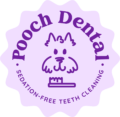Pet owners know the importance of maintaining their dog’s health, but just like humans, dogs also need regular dental care. One of the most effective ways to keep your dog’s teeth and gums healthy is by brushing their teeth regularly! In this blog post, we’ll provide a step-by-step guide on how to properly brush your dog’s teeth to ensure a healthy smile and overall well-being.
Step 1: Choose the right tools
Before you begin brushing your dog’s teeth, make sure you have the right tools on hand:
- Dog-specific toothbrush: Opt for a toothbrush designed specifically for dogs, as they come in various shapes and sizes to suit different breeds and mouth sizes.
- Dog-friendly toothpaste: Never use human toothpaste for your dog, as it may contain harmful ingredients if swallowed. Instead, choose a toothpaste formulated specifically for dogs or use coconut oil.
Step 2: Get your dog accustomed to toothbrushing
Introduce your dog to the toothbrush and toothpaste gradually to make the experience more positive:
- Let your dog sniff and lick the toothbrush and toothpaste to familiarize themselves with the taste and texture.
- Gently rub your finger along your dog’s gums and teeth to get them used to the sensation of having their mouth touched.
- Offer praise and rewards to create a positive association with toothbrushing.
Step 3: Start brushing
Once your dog is comfortable with the toothbrush and toothpaste, you can begin the brushing process:
- Lift your dog’s lips to expose their teeth and gums.
- Place a small amount of toothpaste on the toothbrush and gently brush in a circular motion, focusing on the outer surfaces of the teeth where plaque tends to accumulate.
- Be gentle but thorough, making sure to reach all areas of the mouth, including the back molars!
- Pay extra attention to the gumline, as this is where plaque and tartar are most likely to accumulate.
- Brush for about 2-3 minutes, gradually increasing the duration as your dog becomes more accustomed to the process.
Step 4: Reward and reinforce
After brushing be sure to reward your dog with praise and treats to reinforce positive behaviour:
- Offer a dental chew or toy as a reward for good behaviour during brushing.
- Use verbal praise and affection to let your dog know they’ve done well.
- Make toothbrushing a part of your dog’s routine, ideally brushing their teeth daily or at least several times a week for optimal dental health.
Properly brushing your dog’s teeth is an essential part of their overall healthcare routine. By following these steps and making toothbrushing a positive experience for your dog, you can help prevent dental issues and ensure they enjoy a lifetime of healthy smiles. Start brushing today and give your furry friend the gift of good dental health!


